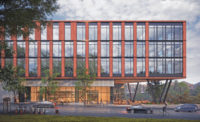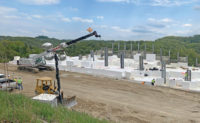COVID-19’s exact toll on the MidAtlantic construction market is still unknown, but one thing is for sure: It could’ve been a lot worse. The ENR MidAtlantic 2020 Top Starts ranking includes 24 projects worth a combined $6.7 billion, down 25.6% from the nearly $9 billion in total project volume in 2019. The new list includes projects that started substantial construction in Delaware, Maryland, Pennsylvania, Virginia, West Virginia and the District of Columbia in 2020. The lists for the last two years are down sharply from the $13.5 billion reported in 2018 and the $21.2 billion in projects on ENR MidAtlantic’s list for 2017.
The rankings are compiled using information from Dodge Data & Analytics as well as details provided by firms and other sources. The minimum value of projects for 2020 was $110 million, down from $200 million in 2019, $185 million in 2018 and $150 million in 2017.
This year’s ranking marks the first time since the 2014 inaugural list that the top-ranked project wasn’t $1 billion or higher. That’s partially due to the fact that Amazon’s $2.5-billion HQ2 development in Northern Virginia—which started demolition in January 2020—is listing phases of the project separately; two towers are listed on this year’s list at $240 million apiece.
The top-ranked project this year was the $800-million DHS FEMA Manufactured Housing Units IDIQ in Washington, D.C., while this year’s third-ranked project was the $636-million Gov. Harry W. Nice/Sen. Thomas “Mac” Middleton Bridge Replacement. The $585-million Facebook Henrico Data Center, Phase 3, in Sandston, Va., ranked third. Phase 2 of that project was ranked No. 1 last year with a value of $1 billion.
Executives from two firms with projects on this year’s list, IMC Construction and ZGF Architects LLP, shared regional market insights with ENR. Their responses have been edited for space and clarity.
|
Related Link |
How do you believe the Biden admin-istration will impact design and construction in the region?
Michael Lloyd, executive vice president, IMC Construction: The more comprehensive and organized manufacture and distribution of vaccines and the relief bill will have a significant impact on the economy and people getting back to normal, which should be a net positive for the industry. We also anticipate an emphasis on LEED and sustainable building techniques.
Tim Williams, partner, ZGF Architects LLP: With the Biden administration, we are excited to see a focus on providing greater opportunity to historically underserved communities. As a result, the industry and administration are poised to make great strides in advancing diversity, inclusion and equity. We are optimistic that the industry will benefit from an upcoming infrastructure deal and that we will see greater incentives for renewable energy and high-performance projects. In D.C. especially, the administration’s reversal of the classical architecture mandate will ensure that our federal projects can appropriately respond to the needs and voices of the communities they serve.
Which sectors have offered the biggest opportunities in the region?
Lloyd: Multifamily, industrial and life sciences.
Williams: We are seeing strong interest in life science facilities and renewed federal opportunities.
Which sectors have cooled down in the region?
Lloyd: Commercial office and higher ed have cooled noticeably. … Markets that have a lower cost per square foot may experience office demand as workforces become more disbursed and companies adopt satellite office strategies.
Williams: ZGF has been fortunate not to observe any slowdown in the sectors in which we are active.
What key innovations helped you boost productivity or other metrics in the region?
Lloyd: Computer modeling has permeated every level of our firm, allowing more accurate pricing earlier and quicker. However, there is a world of have and have nots in the VDC capability arena. Many have outsourced resources only or have limited abilities. Further, modular building components (vs. modular buildings) applications have made increasing impacts.
Williams: While at first these challenges [of collaborating remotely] were daunting, we are seeing great efficiencies in remote work, and our team has quickly adapted to new platforms and digital tools. With commuting and travel eliminated for now, we are seeing significant gains in utilization and productivity.
How do you think the industry is rebounding from COVID-19, and where is the industry headed in the next year or so?
Lloyd: We see an abundance of pent-up projects ready to break. The second half of 2021 is expected to have a noticeable bounce from the vaccine rollout, the flow of funds from the relief bill and people getting back into the economy. The question is, will it be sustainable or will there be a following sluggishness as the economy digests the economic damage from COVID?
Williams: As we emerge from the pandemic, we are seeing the acceleration of trends around health and wellness, sustainability and digital connectivity. The past year has demonstrated how important the built environment is in upholding human health—from designing air circulation systems that mitigate the spread of pathogens to creating biophilic environments that promote psychological and emotional well-being. 2020 was also historic in the number of natural disasters we endured—from wildfires in the West to historic flooding in the Southeast. We must continue to aggressively push sustainable and resilient design solutions while driving innovation in high-performance systems and technologies. Lastly, the pandemic has fundamentally changed the ways in which we work, learn and connect. The industry will play a critical role in shaping our new normal in a world where the digital and physical realms are increasingly interconnected.







Post a comment to this article
Report Abusive Comment